Effective Total Reward Systems in Human Resource Management
VerifiedAdded on 2020/07/22
|9
|3408
|125
Essay
AI Summary
This essay delves into the critical role of reward systems within human resource management. It defines the concept of total reward, encompassing both monetary and non-monetary incentives, and emphasizes its importance in employee motivation and retention. The essay explores various types of rewards, including compensation, bonuses, recognition, and benefits, and discusses their impact on employee performance and work-life balance. It also examines the relationship between total reward systems and Maslow's hierarchy of needs, illustrating how different reward strategies can address employees' physiological, safety, love/belonging, esteem, and self-actualization needs. Furthermore, the essay highlights the benefits of total reward systems, such as improved employee retention, enhanced performance, and cost-effective program management, making it a valuable resource for understanding and implementing effective human resource strategies. The essay emphasizes the importance of aligning reward systems with organizational goals and employee preferences to foster a positive work environment and drive organizational success.
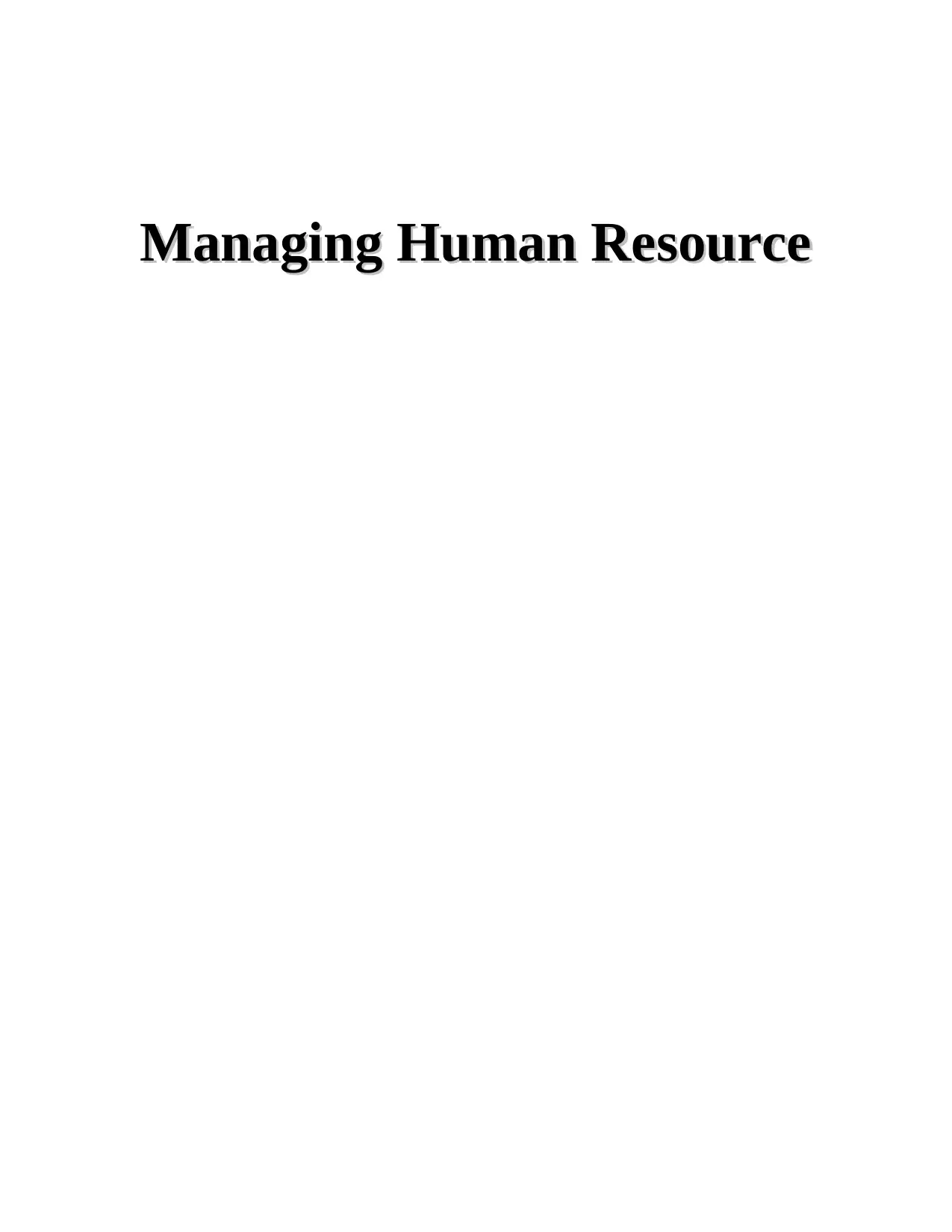
Managing Human ResourceManaging Human Resource
Paraphrase This Document
Need a fresh take? Get an instant paraphrase of this document with our AI Paraphraser
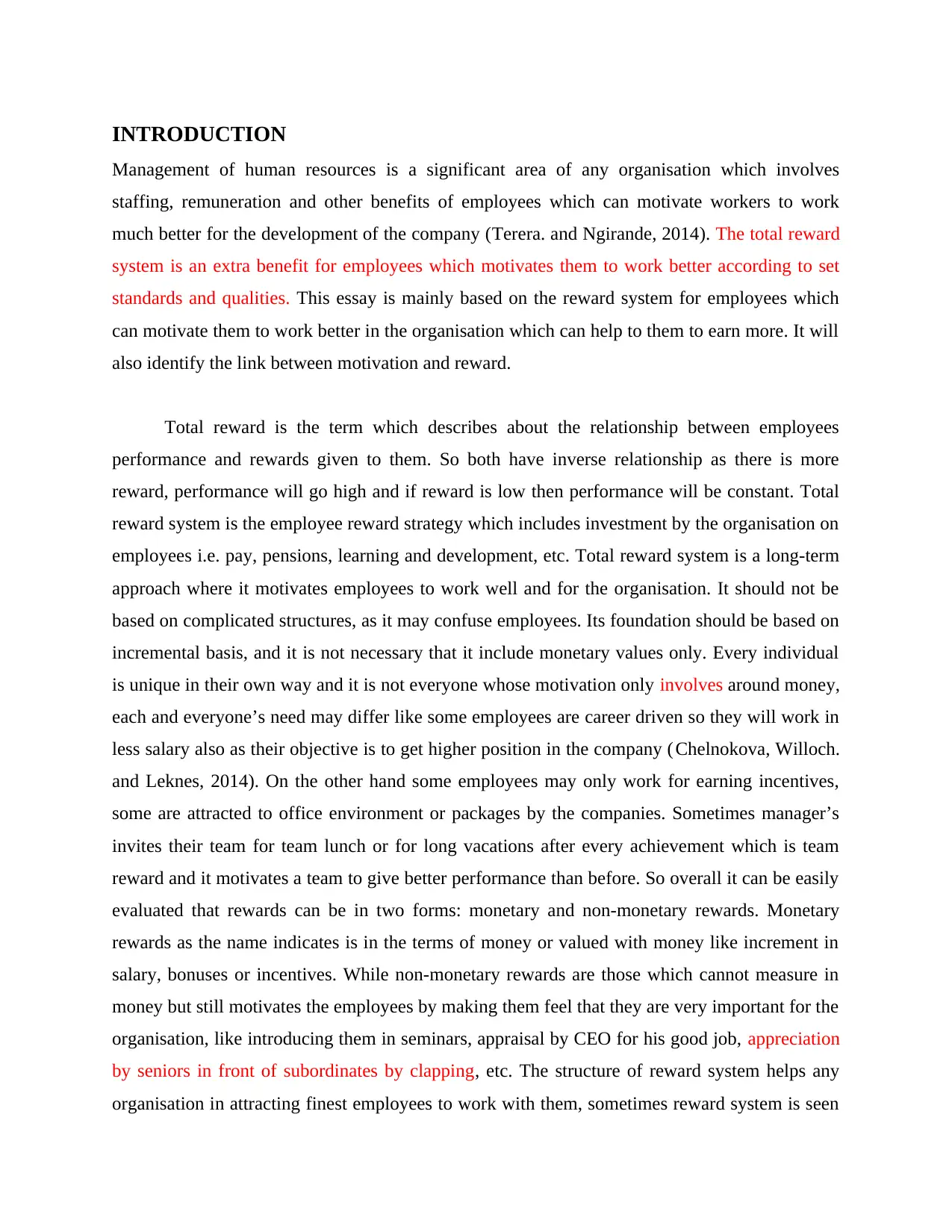
INTRODUCTION
Management of human resources is a significant area of any organisation which involves
staffing, remuneration and other benefits of employees which can motivate workers to work
much better for the development of the company (Terera. and Ngirande, 2014). The total reward
system is an extra benefit for employees which motivates them to work better according to set
standards and qualities. This essay is mainly based on the reward system for employees which
can motivate them to work better in the organisation which can help to them to earn more. It will
also identify the link between motivation and reward.
Total reward is the term which describes about the relationship between employees
performance and rewards given to them. So both have inverse relationship as there is more
reward, performance will go high and if reward is low then performance will be constant. Total
reward system is the employee reward strategy which includes investment by the organisation on
employees i.e. pay, pensions, learning and development, etc. Total reward system is a long-term
approach where it motivates employees to work well and for the organisation. It should not be
based on complicated structures, as it may confuse employees. Its foundation should be based on
incremental basis, and it is not necessary that it include monetary values only. Every individual
is unique in their own way and it is not everyone whose motivation only involves around money,
each and everyone’s need may differ like some employees are career driven so they will work in
less salary also as their objective is to get higher position in the company (Chelnokova, Willoch.
and Leknes, 2014). On the other hand some employees may only work for earning incentives,
some are attracted to office environment or packages by the companies. Sometimes manager’s
invites their team for team lunch or for long vacations after every achievement which is team
reward and it motivates a team to give better performance than before. So overall it can be easily
evaluated that rewards can be in two forms: monetary and non-monetary rewards. Monetary
rewards as the name indicates is in the terms of money or valued with money like increment in
salary, bonuses or incentives. While non-monetary rewards are those which cannot measure in
money but still motivates the employees by making them feel that they are very important for the
organisation, like introducing them in seminars, appraisal by CEO for his good job, appreciation
by seniors in front of subordinates by clapping, etc. The structure of reward system helps any
organisation in attracting finest employees to work with them, sometimes reward system is seen
Management of human resources is a significant area of any organisation which involves
staffing, remuneration and other benefits of employees which can motivate workers to work
much better for the development of the company (Terera. and Ngirande, 2014). The total reward
system is an extra benefit for employees which motivates them to work better according to set
standards and qualities. This essay is mainly based on the reward system for employees which
can motivate them to work better in the organisation which can help to them to earn more. It will
also identify the link between motivation and reward.
Total reward is the term which describes about the relationship between employees
performance and rewards given to them. So both have inverse relationship as there is more
reward, performance will go high and if reward is low then performance will be constant. Total
reward system is the employee reward strategy which includes investment by the organisation on
employees i.e. pay, pensions, learning and development, etc. Total reward system is a long-term
approach where it motivates employees to work well and for the organisation. It should not be
based on complicated structures, as it may confuse employees. Its foundation should be based on
incremental basis, and it is not necessary that it include monetary values only. Every individual
is unique in their own way and it is not everyone whose motivation only involves around money,
each and everyone’s need may differ like some employees are career driven so they will work in
less salary also as their objective is to get higher position in the company (Chelnokova, Willoch.
and Leknes, 2014). On the other hand some employees may only work for earning incentives,
some are attracted to office environment or packages by the companies. Sometimes manager’s
invites their team for team lunch or for long vacations after every achievement which is team
reward and it motivates a team to give better performance than before. So overall it can be easily
evaluated that rewards can be in two forms: monetary and non-monetary rewards. Monetary
rewards as the name indicates is in the terms of money or valued with money like increment in
salary, bonuses or incentives. While non-monetary rewards are those which cannot measure in
money but still motivates the employees by making them feel that they are very important for the
organisation, like introducing them in seminars, appraisal by CEO for his good job, appreciation
by seniors in front of subordinates by clapping, etc. The structure of reward system helps any
organisation in attracting finest employees to work with them, sometimes reward system is seen
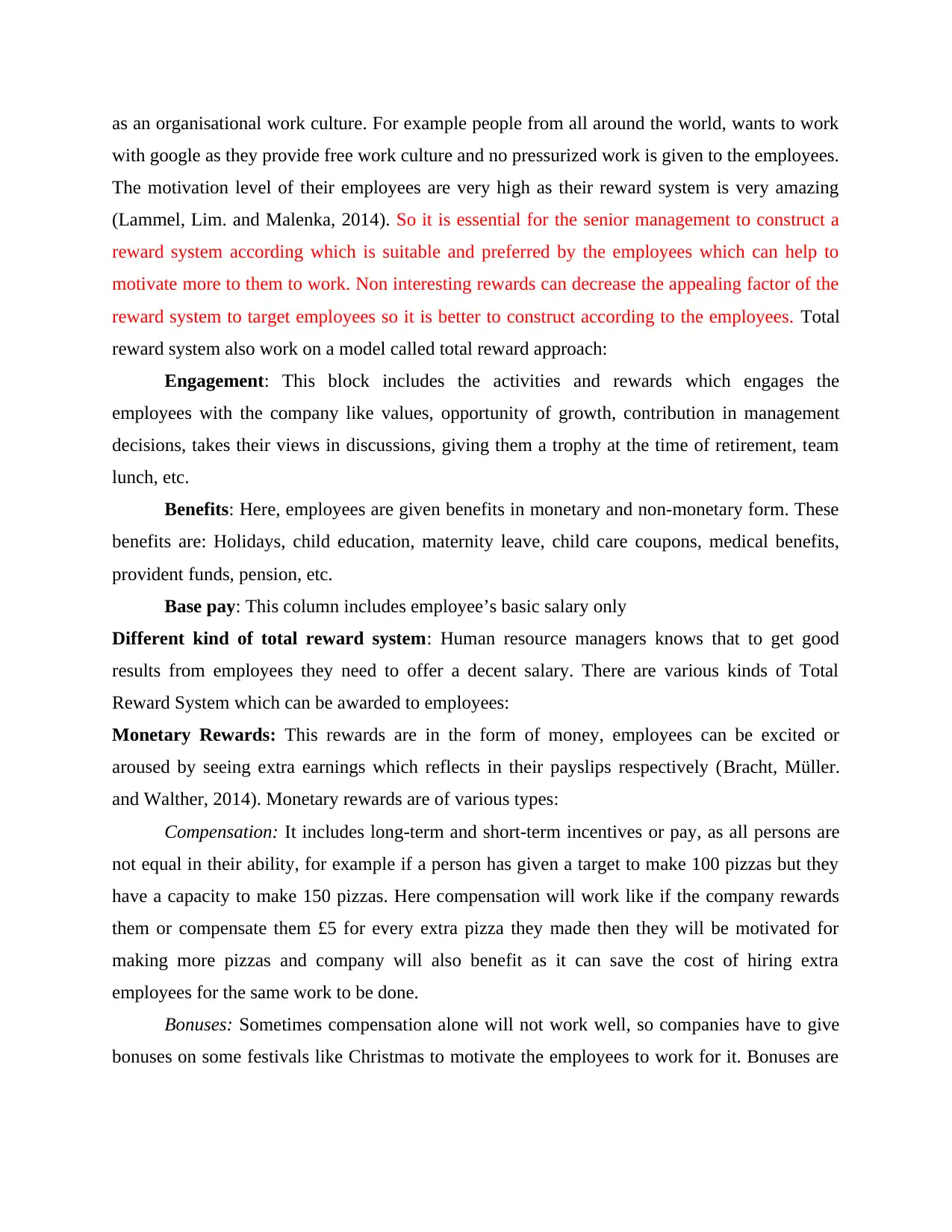
as an organisational work culture. For example people from all around the world, wants to work
with google as they provide free work culture and no pressurized work is given to the employees.
The motivation level of their employees are very high as their reward system is very amazing
(Lammel, Lim. and Malenka, 2014). So it is essential for the senior management to construct a
reward system according which is suitable and preferred by the employees which can help to
motivate more to them to work. Non interesting rewards can decrease the appealing factor of the
reward system to target employees so it is better to construct according to the employees. Total
reward system also work on a model called total reward approach:
Engagement: This block includes the activities and rewards which engages the
employees with the company like values, opportunity of growth, contribution in management
decisions, takes their views in discussions, giving them a trophy at the time of retirement, team
lunch, etc.
Benefits: Here, employees are given benefits in monetary and non-monetary form. These
benefits are: Holidays, child education, maternity leave, child care coupons, medical benefits,
provident funds, pension, etc.
Base pay: This column includes employee’s basic salary only
Different kind of total reward system: Human resource managers knows that to get good
results from employees they need to offer a decent salary. There are various kinds of Total
Reward System which can be awarded to employees:
Monetary Rewards: This rewards are in the form of money, employees can be excited or
aroused by seeing extra earnings which reflects in their payslips respectively (Bracht, Müller.
and Walther, 2014). Monetary rewards are of various types:
Compensation: It includes long-term and short-term incentives or pay, as all persons are
not equal in their ability, for example if a person has given a target to make 100 pizzas but they
have a capacity to make 150 pizzas. Here compensation will work like if the company rewards
them or compensate them £5 for every extra pizza they made then they will be motivated for
making more pizzas and company will also benefit as it can save the cost of hiring extra
employees for the same work to be done.
Bonuses: Sometimes compensation alone will not work well, so companies have to give
bonuses on some festivals like Christmas to motivate the employees to work for it. Bonuses are
with google as they provide free work culture and no pressurized work is given to the employees.
The motivation level of their employees are very high as their reward system is very amazing
(Lammel, Lim. and Malenka, 2014). So it is essential for the senior management to construct a
reward system according which is suitable and preferred by the employees which can help to
motivate more to them to work. Non interesting rewards can decrease the appealing factor of the
reward system to target employees so it is better to construct according to the employees. Total
reward system also work on a model called total reward approach:
Engagement: This block includes the activities and rewards which engages the
employees with the company like values, opportunity of growth, contribution in management
decisions, takes their views in discussions, giving them a trophy at the time of retirement, team
lunch, etc.
Benefits: Here, employees are given benefits in monetary and non-monetary form. These
benefits are: Holidays, child education, maternity leave, child care coupons, medical benefits,
provident funds, pension, etc.
Base pay: This column includes employee’s basic salary only
Different kind of total reward system: Human resource managers knows that to get good
results from employees they need to offer a decent salary. There are various kinds of Total
Reward System which can be awarded to employees:
Monetary Rewards: This rewards are in the form of money, employees can be excited or
aroused by seeing extra earnings which reflects in their payslips respectively (Bracht, Müller.
and Walther, 2014). Monetary rewards are of various types:
Compensation: It includes long-term and short-term incentives or pay, as all persons are
not equal in their ability, for example if a person has given a target to make 100 pizzas but they
have a capacity to make 150 pizzas. Here compensation will work like if the company rewards
them or compensate them £5 for every extra pizza they made then they will be motivated for
making more pizzas and company will also benefit as it can save the cost of hiring extra
employees for the same work to be done.
Bonuses: Sometimes compensation alone will not work well, so companies have to give
bonuses on some festivals like Christmas to motivate the employees to work for it. Bonuses are
⊘ This is a preview!⊘
Do you want full access?
Subscribe today to unlock all pages.

Trusted by 1+ million students worldwide
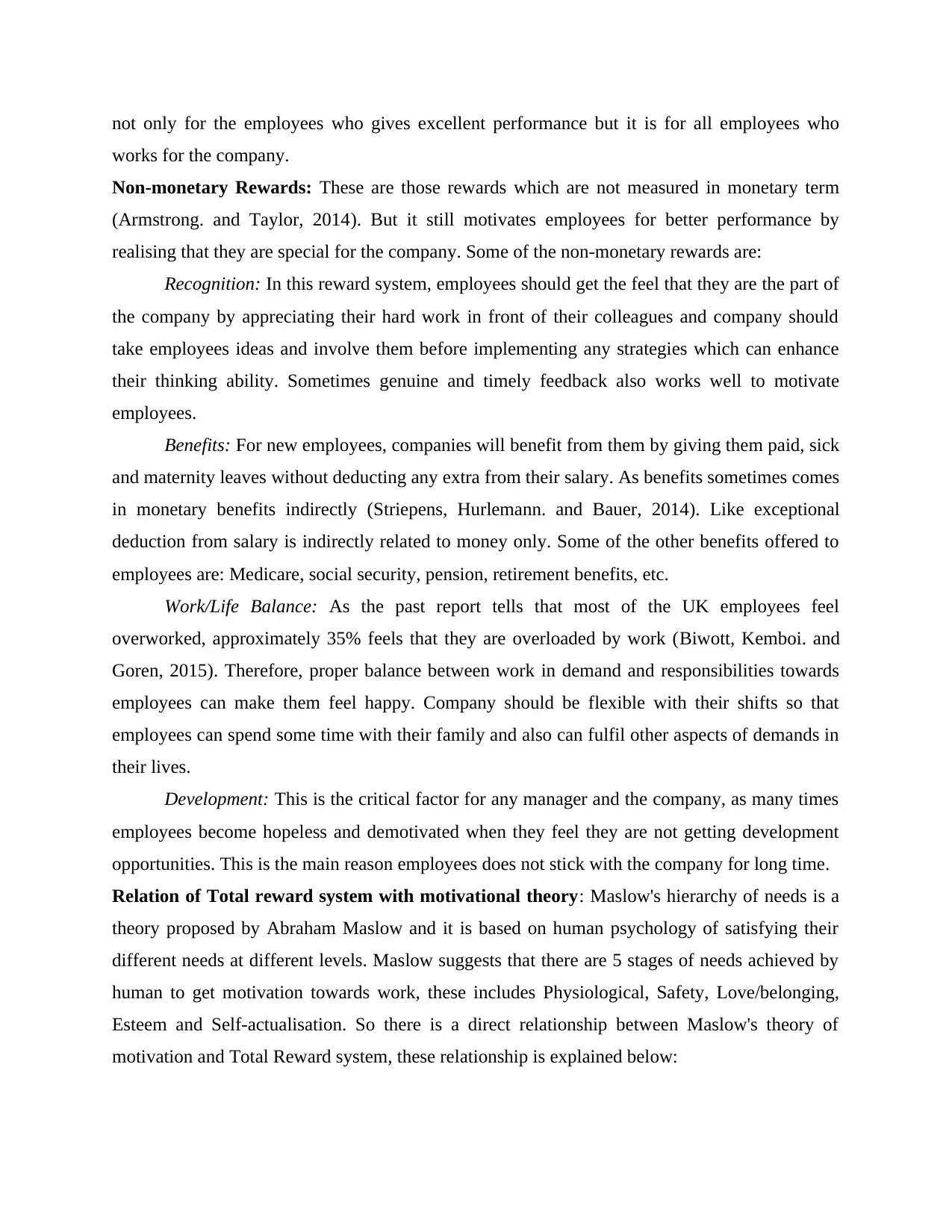
not only for the employees who gives excellent performance but it is for all employees who
works for the company.
Non-monetary Rewards: These are those rewards which are not measured in monetary term
(Armstrong. and Taylor, 2014). But it still motivates employees for better performance by
realising that they are special for the company. Some of the non-monetary rewards are:
Recognition: In this reward system, employees should get the feel that they are the part of
the company by appreciating their hard work in front of their colleagues and company should
take employees ideas and involve them before implementing any strategies which can enhance
their thinking ability. Sometimes genuine and timely feedback also works well to motivate
employees.
Benefits: For new employees, companies will benefit from them by giving them paid, sick
and maternity leaves without deducting any extra from their salary. As benefits sometimes comes
in monetary benefits indirectly (Striepens, Hurlemann. and Bauer, 2014). Like exceptional
deduction from salary is indirectly related to money only. Some of the other benefits offered to
employees are: Medicare, social security, pension, retirement benefits, etc.
Work/Life Balance: As the past report tells that most of the UK employees feel
overworked, approximately 35% feels that they are overloaded by work (Biwott, Kemboi. and
Goren, 2015). Therefore, proper balance between work in demand and responsibilities towards
employees can make them feel happy. Company should be flexible with their shifts so that
employees can spend some time with their family and also can fulfil other aspects of demands in
their lives.
Development: This is the critical factor for any manager and the company, as many times
employees become hopeless and demotivated when they feel they are not getting development
opportunities. This is the main reason employees does not stick with the company for long time.
Relation of Total reward system with motivational theory: Maslow's hierarchy of needs is a
theory proposed by Abraham Maslow and it is based on human psychology of satisfying their
different needs at different levels. Maslow suggests that there are 5 stages of needs achieved by
human to get motivation towards work, these includes Physiological, Safety, Love/belonging,
Esteem and Self-actualisation. So there is a direct relationship between Maslow's theory of
motivation and Total Reward system, these relationship is explained below:
works for the company.
Non-monetary Rewards: These are those rewards which are not measured in monetary term
(Armstrong. and Taylor, 2014). But it still motivates employees for better performance by
realising that they are special for the company. Some of the non-monetary rewards are:
Recognition: In this reward system, employees should get the feel that they are the part of
the company by appreciating their hard work in front of their colleagues and company should
take employees ideas and involve them before implementing any strategies which can enhance
their thinking ability. Sometimes genuine and timely feedback also works well to motivate
employees.
Benefits: For new employees, companies will benefit from them by giving them paid, sick
and maternity leaves without deducting any extra from their salary. As benefits sometimes comes
in monetary benefits indirectly (Striepens, Hurlemann. and Bauer, 2014). Like exceptional
deduction from salary is indirectly related to money only. Some of the other benefits offered to
employees are: Medicare, social security, pension, retirement benefits, etc.
Work/Life Balance: As the past report tells that most of the UK employees feel
overworked, approximately 35% feels that they are overloaded by work (Biwott, Kemboi. and
Goren, 2015). Therefore, proper balance between work in demand and responsibilities towards
employees can make them feel happy. Company should be flexible with their shifts so that
employees can spend some time with their family and also can fulfil other aspects of demands in
their lives.
Development: This is the critical factor for any manager and the company, as many times
employees become hopeless and demotivated when they feel they are not getting development
opportunities. This is the main reason employees does not stick with the company for long time.
Relation of Total reward system with motivational theory: Maslow's hierarchy of needs is a
theory proposed by Abraham Maslow and it is based on human psychology of satisfying their
different needs at different levels. Maslow suggests that there are 5 stages of needs achieved by
human to get motivation towards work, these includes Physiological, Safety, Love/belonging,
Esteem and Self-actualisation. So there is a direct relationship between Maslow's theory of
motivation and Total Reward system, these relationship is explained below:
Paraphrase This Document
Need a fresh take? Get an instant paraphrase of this document with our AI Paraphraser
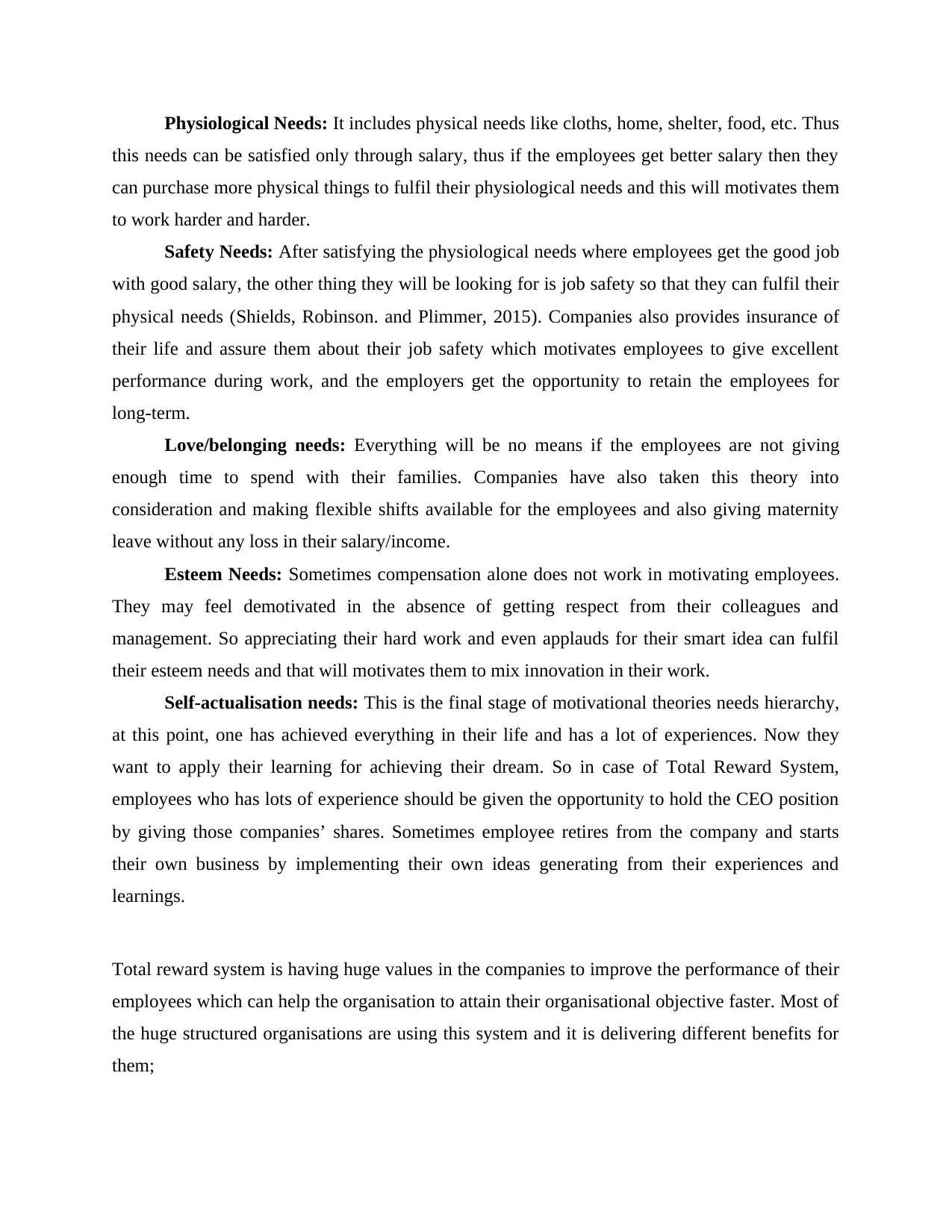
Physiological Needs: It includes physical needs like cloths, home, shelter, food, etc. Thus
this needs can be satisfied only through salary, thus if the employees get better salary then they
can purchase more physical things to fulfil their physiological needs and this will motivates them
to work harder and harder.
Safety Needs: After satisfying the physiological needs where employees get the good job
with good salary, the other thing they will be looking for is job safety so that they can fulfil their
physical needs (Shields, Robinson. and Plimmer, 2015). Companies also provides insurance of
their life and assure them about their job safety which motivates employees to give excellent
performance during work, and the employers get the opportunity to retain the employees for
long-term.
Love/belonging needs: Everything will be no means if the employees are not giving
enough time to spend with their families. Companies have also taken this theory into
consideration and making flexible shifts available for the employees and also giving maternity
leave without any loss in their salary/income.
Esteem Needs: Sometimes compensation alone does not work in motivating employees.
They may feel demotivated in the absence of getting respect from their colleagues and
management. So appreciating their hard work and even applauds for their smart idea can fulfil
their esteem needs and that will motivates them to mix innovation in their work.
Self-actualisation needs: This is the final stage of motivational theories needs hierarchy,
at this point, one has achieved everything in their life and has a lot of experiences. Now they
want to apply their learning for achieving their dream. So in case of Total Reward System,
employees who has lots of experience should be given the opportunity to hold the CEO position
by giving those companies’ shares. Sometimes employee retires from the company and starts
their own business by implementing their own ideas generating from their experiences and
learnings.
Total reward system is having huge values in the companies to improve the performance of their
employees which can help the organisation to attain their organisational objective faster. Most of
the huge structured organisations are using this system and it is delivering different benefits for
them;
this needs can be satisfied only through salary, thus if the employees get better salary then they
can purchase more physical things to fulfil their physiological needs and this will motivates them
to work harder and harder.
Safety Needs: After satisfying the physiological needs where employees get the good job
with good salary, the other thing they will be looking for is job safety so that they can fulfil their
physical needs (Shields, Robinson. and Plimmer, 2015). Companies also provides insurance of
their life and assure them about their job safety which motivates employees to give excellent
performance during work, and the employers get the opportunity to retain the employees for
long-term.
Love/belonging needs: Everything will be no means if the employees are not giving
enough time to spend with their families. Companies have also taken this theory into
consideration and making flexible shifts available for the employees and also giving maternity
leave without any loss in their salary/income.
Esteem Needs: Sometimes compensation alone does not work in motivating employees.
They may feel demotivated in the absence of getting respect from their colleagues and
management. So appreciating their hard work and even applauds for their smart idea can fulfil
their esteem needs and that will motivates them to mix innovation in their work.
Self-actualisation needs: This is the final stage of motivational theories needs hierarchy,
at this point, one has achieved everything in their life and has a lot of experiences. Now they
want to apply their learning for achieving their dream. So in case of Total Reward System,
employees who has lots of experience should be given the opportunity to hold the CEO position
by giving those companies’ shares. Sometimes employee retires from the company and starts
their own business by implementing their own ideas generating from their experiences and
learnings.
Total reward system is having huge values in the companies to improve the performance of their
employees which can help the organisation to attain their organisational objective faster. Most of
the huge structured organisations are using this system and it is delivering different benefits for
them;
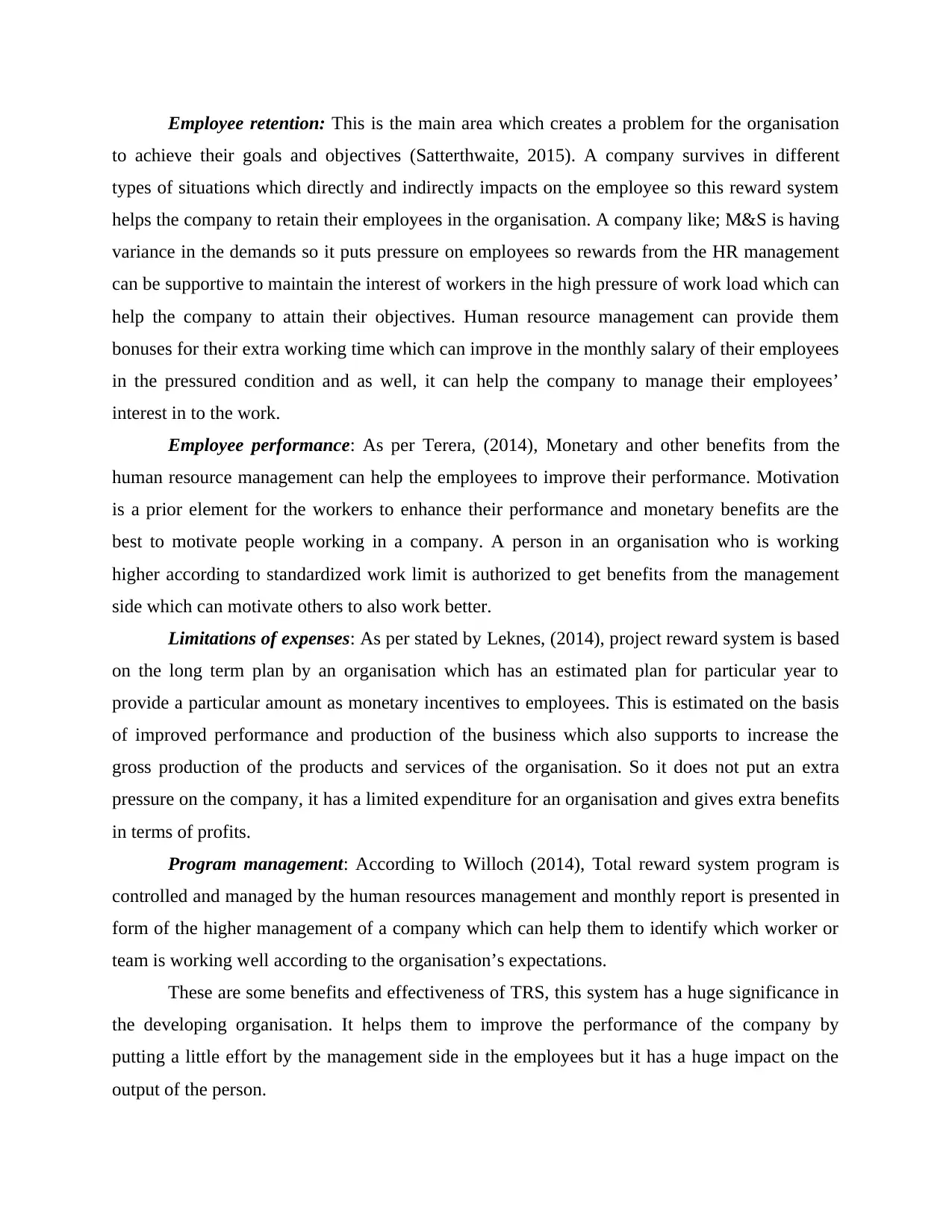
Employee retention: This is the main area which creates a problem for the organisation
to achieve their goals and objectives (Satterthwaite, 2015). A company survives in different
types of situations which directly and indirectly impacts on the employee so this reward system
helps the company to retain their employees in the organisation. A company like; M&S is having
variance in the demands so it puts pressure on employees so rewards from the HR management
can be supportive to maintain the interest of workers in the high pressure of work load which can
help the company to attain their objectives. Human resource management can provide them
bonuses for their extra working time which can improve in the monthly salary of their employees
in the pressured condition and as well, it can help the company to manage their employees’
interest in to the work.
Employee performance: As per Terera, (2014), Monetary and other benefits from the
human resource management can help the employees to improve their performance. Motivation
is a prior element for the workers to enhance their performance and monetary benefits are the
best to motivate people working in a company. A person in an organisation who is working
higher according to standardized work limit is authorized to get benefits from the management
side which can motivate others to also work better.
Limitations of expenses: As per stated by Leknes, (2014), project reward system is based
on the long term plan by an organisation which has an estimated plan for particular year to
provide a particular amount as monetary incentives to employees. This is estimated on the basis
of improved performance and production of the business which also supports to increase the
gross production of the products and services of the organisation. So it does not put an extra
pressure on the company, it has a limited expenditure for an organisation and gives extra benefits
in terms of profits.
Program management: According to Willoch (2014), Total reward system program is
controlled and managed by the human resources management and monthly report is presented in
form of the higher management of a company which can help them to identify which worker or
team is working well according to the organisation’s expectations.
These are some benefits and effectiveness of TRS, this system has a huge significance in
the developing organisation. It helps them to improve the performance of the company by
putting a little effort by the management side in the employees but it has a huge impact on the
output of the person.
to achieve their goals and objectives (Satterthwaite, 2015). A company survives in different
types of situations which directly and indirectly impacts on the employee so this reward system
helps the company to retain their employees in the organisation. A company like; M&S is having
variance in the demands so it puts pressure on employees so rewards from the HR management
can be supportive to maintain the interest of workers in the high pressure of work load which can
help the company to attain their objectives. Human resource management can provide them
bonuses for their extra working time which can improve in the monthly salary of their employees
in the pressured condition and as well, it can help the company to manage their employees’
interest in to the work.
Employee performance: As per Terera, (2014), Monetary and other benefits from the
human resource management can help the employees to improve their performance. Motivation
is a prior element for the workers to enhance their performance and monetary benefits are the
best to motivate people working in a company. A person in an organisation who is working
higher according to standardized work limit is authorized to get benefits from the management
side which can motivate others to also work better.
Limitations of expenses: As per stated by Leknes, (2014), project reward system is based
on the long term plan by an organisation which has an estimated plan for particular year to
provide a particular amount as monetary incentives to employees. This is estimated on the basis
of improved performance and production of the business which also supports to increase the
gross production of the products and services of the organisation. So it does not put an extra
pressure on the company, it has a limited expenditure for an organisation and gives extra benefits
in terms of profits.
Program management: According to Willoch (2014), Total reward system program is
controlled and managed by the human resources management and monthly report is presented in
form of the higher management of a company which can help them to identify which worker or
team is working well according to the organisation’s expectations.
These are some benefits and effectiveness of TRS, this system has a huge significance in
the developing organisation. It helps them to improve the performance of the company by
putting a little effort by the management side in the employees but it has a huge impact on the
output of the person.
⊘ This is a preview!⊘
Do you want full access?
Subscribe today to unlock all pages.

Trusted by 1+ million students worldwide

Total reward system is used in different sectors e.g. education and policing to improve
the performance of teachers and police. Both sectors are working for the public cause and having
a focus to provide a better service to the public. Below is a comparison of the total reward
system in both sectors;
Objective: As per the view of Lammel (2014), in the policing sector, objective of total
reward system is to improve public security by providing rewards to employees which can help
the government to reduce the graph of anti-social activities. It is essential for the governance to
provide a better environment to the public to live in society. Implementation of reward system is
just not having an objective to increase the duty time of the policeman but also to improve their
working to uproot anti-social activities in the society by their patrolling. In the education sector it
is having an objective to enhance the time of lectures for the better and more education to
students which can help the teacher as well as student in depth learning and questioning for
qualitative study. In the education sector rewards can be given in term of long duration holidays
after a tough and busy schedules session. So in the teaching sector it is used to improve the
working hours and policing sector to improve the quality patrolling by the policeman.
Effectiveness: Total reward system is having huge value and effectiveness in the policing
sector because policeman is has a huge need of these kind of motivation (Malenka, 2014). They
work in typical conditions to provide a better social environment to people to live in it so the
TRS helps to work in the bad conditions. In the teaching sector it helps as teachers dedicates
more time and effort to teaching which can finally impact positively on the studies of the
students. TRS has much effectiveness in the policing sector because it is ultimately having
impact on their performance but in the teaching sector there can be less use of TRS.
Type of rewards used: Walther (2014), stated that in policing sector designation, star
mark, vehicles and positioning are the main elements which can be used in the TRS which can
help assist the police to perform better in their task. Cars and bikes can be used in to the
patrolling these are non-monetary benefits which can motivate to others to work better in their
task to get these types of facilities by their superiors. Mostly, over time compensation is given in
the teaching industry to improve the time line of service period to deliver a depth knowledge to
students. This is a direct monetary benefit which motivates teachers to render their extra time in
the schools. So the TRS is highly impactive in the policing industry because it helps to improve
the performance of teachers and police. Both sectors are working for the public cause and having
a focus to provide a better service to the public. Below is a comparison of the total reward
system in both sectors;
Objective: As per the view of Lammel (2014), in the policing sector, objective of total
reward system is to improve public security by providing rewards to employees which can help
the government to reduce the graph of anti-social activities. It is essential for the governance to
provide a better environment to the public to live in society. Implementation of reward system is
just not having an objective to increase the duty time of the policeman but also to improve their
working to uproot anti-social activities in the society by their patrolling. In the education sector it
is having an objective to enhance the time of lectures for the better and more education to
students which can help the teacher as well as student in depth learning and questioning for
qualitative study. In the education sector rewards can be given in term of long duration holidays
after a tough and busy schedules session. So in the teaching sector it is used to improve the
working hours and policing sector to improve the quality patrolling by the policeman.
Effectiveness: Total reward system is having huge value and effectiveness in the policing
sector because policeman is has a huge need of these kind of motivation (Malenka, 2014). They
work in typical conditions to provide a better social environment to people to live in it so the
TRS helps to work in the bad conditions. In the teaching sector it helps as teachers dedicates
more time and effort to teaching which can finally impact positively on the studies of the
students. TRS has much effectiveness in the policing sector because it is ultimately having
impact on their performance but in the teaching sector there can be less use of TRS.
Type of rewards used: Walther (2014), stated that in policing sector designation, star
mark, vehicles and positioning are the main elements which can be used in the TRS which can
help assist the police to perform better in their task. Cars and bikes can be used in to the
patrolling these are non-monetary benefits which can motivate to others to work better in their
task to get these types of facilities by their superiors. Mostly, over time compensation is given in
the teaching industry to improve the time line of service period to deliver a depth knowledge to
students. This is a direct monetary benefit which motivates teachers to render their extra time in
the schools. So the TRS is highly impactive in the policing industry because it helps to improve
Paraphrase This Document
Need a fresh take? Get an instant paraphrase of this document with our AI Paraphraser

designation, monetary and other benefits as compare to teaching industry. Total reward system in
different sectors are given in several ways. For example, in teaching sector bonus or incentives
are provided to them. As it also increases the salary of employees by motivating them in terms of
taking feedbacks from them. In contrary to this, compensation is provided in terms of non-
monetary in police sector so that they can perform their duties in appropriate manner. As it will
also motivate them to strictly follow the rules and regulations which are made by government in
order to get some additional benefit from them.
CONCLUSION
The above presented report has been concluded about the different types of total reward system
to enhance the productivity of employees for organisational development. Incentives and
monetary benefits are having a huge impact on the motivational level of employees which
impacts on them to work more to make more and more incentives. TRS has delivered many
advantages to companies or SME, mainly in retaining their employees which is a priority for
them. In the teaching sector it has a huge impact on the performance of the teachers because it
supports the teachers to give extra time for students in resolving their issues, the same in the
policing sector, improvement in the designation and other benefits motivates to other policemen
to work better. As there are many people who are working in different sectors and reward is
giving to them according to their profession and level of position. As it will assist in performing
their duties and task in innovative way for targeting their own goals and objectives also. As in
teaching sector, teacher has to give more time to students to increase their knowledge and skills
so it is essential for them to motivate in different ways.
different sectors are given in several ways. For example, in teaching sector bonus or incentives
are provided to them. As it also increases the salary of employees by motivating them in terms of
taking feedbacks from them. In contrary to this, compensation is provided in terms of non-
monetary in police sector so that they can perform their duties in appropriate manner. As it will
also motivate them to strictly follow the rules and regulations which are made by government in
order to get some additional benefit from them.
CONCLUSION
The above presented report has been concluded about the different types of total reward system
to enhance the productivity of employees for organisational development. Incentives and
monetary benefits are having a huge impact on the motivational level of employees which
impacts on them to work more to make more and more incentives. TRS has delivered many
advantages to companies or SME, mainly in retaining their employees which is a priority for
them. In the teaching sector it has a huge impact on the performance of the teachers because it
supports the teachers to give extra time for students in resolving their issues, the same in the
policing sector, improvement in the designation and other benefits motivates to other policemen
to work better. As there are many people who are working in different sectors and reward is
giving to them according to their profession and level of position. As it will assist in performing
their duties and task in innovative way for targeting their own goals and objectives also. As in
teaching sector, teacher has to give more time to students to increase their knowledge and skills
so it is essential for them to motivate in different ways.
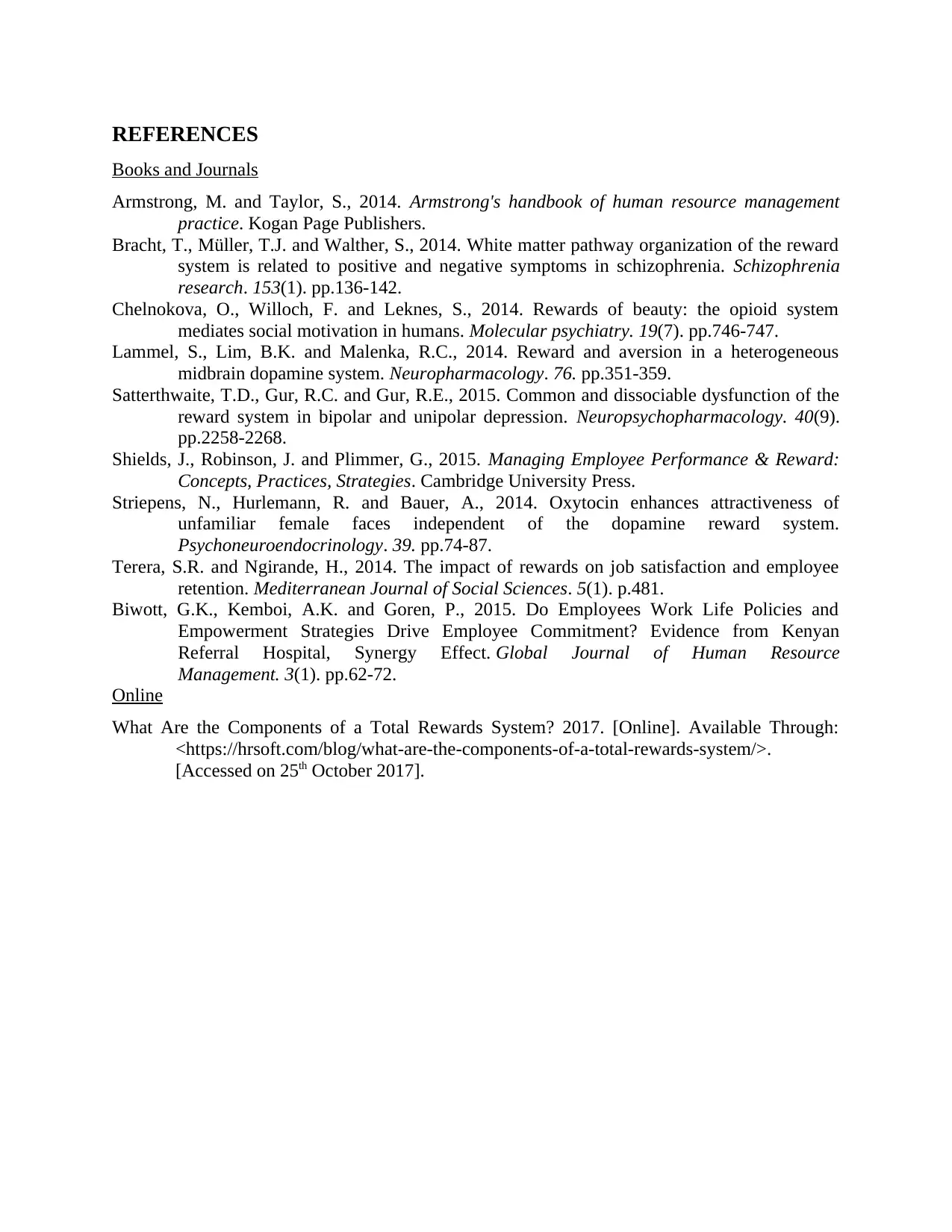
REFERENCES
Books and Journals
Armstrong, M. and Taylor, S., 2014. Armstrong's handbook of human resource management
practice. Kogan Page Publishers.
Bracht, T., Müller, T.J. and Walther, S., 2014. White matter pathway organization of the reward
system is related to positive and negative symptoms in schizophrenia. Schizophrenia
research. 153(1). pp.136-142.
Chelnokova, O., Willoch, F. and Leknes, S., 2014. Rewards of beauty: the opioid system
mediates social motivation in humans. Molecular psychiatry. 19(7). pp.746-747.
Lammel, S., Lim, B.K. and Malenka, R.C., 2014. Reward and aversion in a heterogeneous
midbrain dopamine system. Neuropharmacology. 76. pp.351-359.
Satterthwaite, T.D., Gur, R.C. and Gur, R.E., 2015. Common and dissociable dysfunction of the
reward system in bipolar and unipolar depression. Neuropsychopharmacology. 40(9).
pp.2258-2268.
Shields, J., Robinson, J. and Plimmer, G., 2015. Managing Employee Performance & Reward:
Concepts, Practices, Strategies. Cambridge University Press.
Striepens, N., Hurlemann, R. and Bauer, A., 2014. Oxytocin enhances attractiveness of
unfamiliar female faces independent of the dopamine reward system.
Psychoneuroendocrinology. 39. pp.74-87.
Terera, S.R. and Ngirande, H., 2014. The impact of rewards on job satisfaction and employee
retention. Mediterranean Journal of Social Sciences. 5(1). p.481.
Biwott, G.K., Kemboi, A.K. and Goren, P., 2015. Do Employees Work Life Policies and
Empowerment Strategies Drive Employee Commitment? Evidence from Kenyan
Referral Hospital, Synergy Effect. Global Journal of Human Resource
Management. 3(1). pp.62-72.
Online
What Are the Components of a Total Rewards System? 2017. [Online]. Available Through:
<https://hrsoft.com/blog/what-are-the-components-of-a-total-rewards-system/>.
[Accessed on 25th October 2017].
Books and Journals
Armstrong, M. and Taylor, S., 2014. Armstrong's handbook of human resource management
practice. Kogan Page Publishers.
Bracht, T., Müller, T.J. and Walther, S., 2014. White matter pathway organization of the reward
system is related to positive and negative symptoms in schizophrenia. Schizophrenia
research. 153(1). pp.136-142.
Chelnokova, O., Willoch, F. and Leknes, S., 2014. Rewards of beauty: the opioid system
mediates social motivation in humans. Molecular psychiatry. 19(7). pp.746-747.
Lammel, S., Lim, B.K. and Malenka, R.C., 2014. Reward and aversion in a heterogeneous
midbrain dopamine system. Neuropharmacology. 76. pp.351-359.
Satterthwaite, T.D., Gur, R.C. and Gur, R.E., 2015. Common and dissociable dysfunction of the
reward system in bipolar and unipolar depression. Neuropsychopharmacology. 40(9).
pp.2258-2268.
Shields, J., Robinson, J. and Plimmer, G., 2015. Managing Employee Performance & Reward:
Concepts, Practices, Strategies. Cambridge University Press.
Striepens, N., Hurlemann, R. and Bauer, A., 2014. Oxytocin enhances attractiveness of
unfamiliar female faces independent of the dopamine reward system.
Psychoneuroendocrinology. 39. pp.74-87.
Terera, S.R. and Ngirande, H., 2014. The impact of rewards on job satisfaction and employee
retention. Mediterranean Journal of Social Sciences. 5(1). p.481.
Biwott, G.K., Kemboi, A.K. and Goren, P., 2015. Do Employees Work Life Policies and
Empowerment Strategies Drive Employee Commitment? Evidence from Kenyan
Referral Hospital, Synergy Effect. Global Journal of Human Resource
Management. 3(1). pp.62-72.
Online
What Are the Components of a Total Rewards System? 2017. [Online]. Available Through:
<https://hrsoft.com/blog/what-are-the-components-of-a-total-rewards-system/>.
[Accessed on 25th October 2017].
⊘ This is a preview!⊘
Do you want full access?
Subscribe today to unlock all pages.

Trusted by 1+ million students worldwide
1 out of 9
Related Documents
Your All-in-One AI-Powered Toolkit for Academic Success.
+13062052269
info@desklib.com
Available 24*7 on WhatsApp / Email
![[object Object]](/_next/static/media/star-bottom.7253800d.svg)
Unlock your academic potential
Copyright © 2020–2025 A2Z Services. All Rights Reserved. Developed and managed by ZUCOL.




